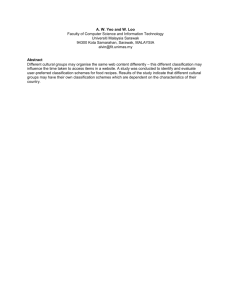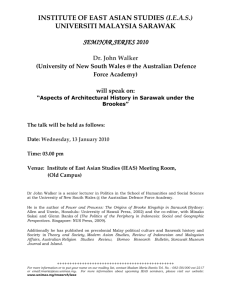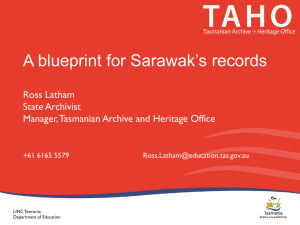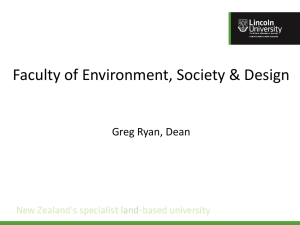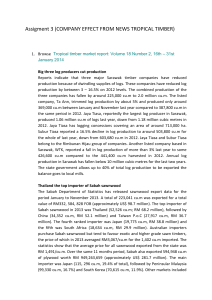1 This first chapter is divided into... background of study which is about scope of tourism, focusing...
advertisement
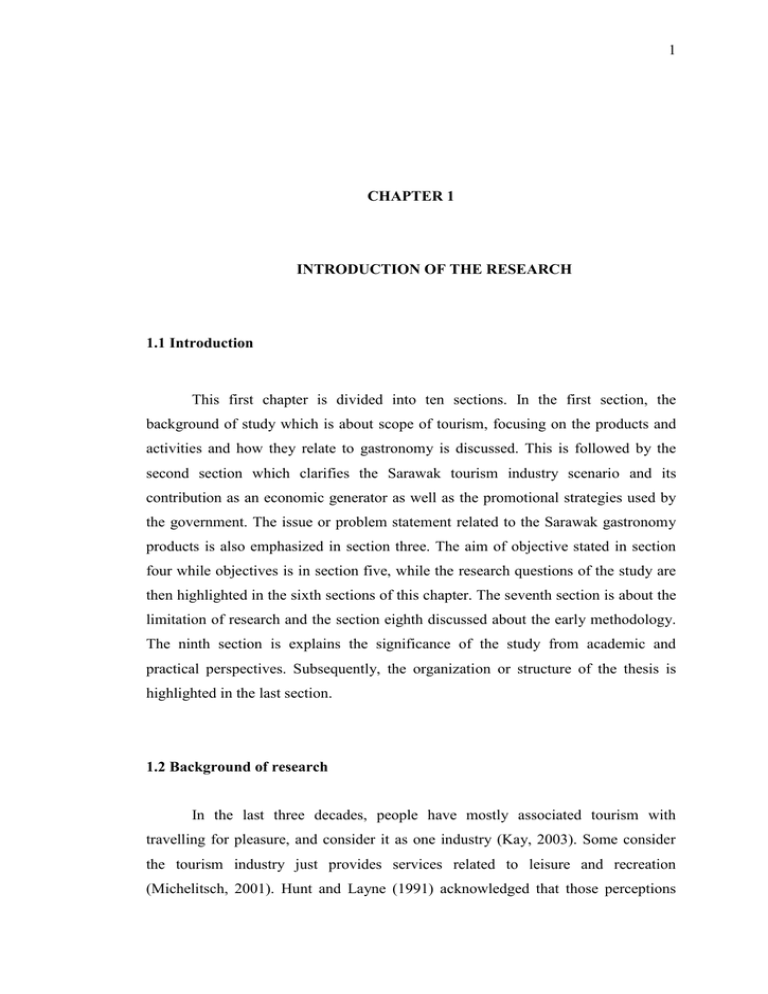
1 CHAPTER 1 INTRODUCTION OF THE RESEARCH 1.1 Introduction This first chapter is divided into ten sections. In the first section, the background of study which is about scope of tourism, focusing on the products and activities and how they relate to gastronomy is discussed. This is followed by the second section which clarifies the Sarawak tourism industry scenario and its contribution as an economic generator as well as the promotional strategies used by the government. The issue or problem statement related to the Sarawak gastronomy products is also emphasized in section three. The aim of objective stated in section four while objectives is in section five, while the research questions of the study are then highlighted in the sixth sections of this chapter. The seventh section is about the limitation of research and the section eighth discussed about the early methodology. The ninth section is explains the significance of the study from academic and practical perspectives. Subsequently, the organization or structure of the thesis is highlighted in the last section. 1.2 Background of research In the last three decades, people have mostly associated tourism with travelling for pleasure, and consider it as one industry (Kay, 2003). Some consider the tourism industry just provides services related to leisure and recreation (Michelitsch, 2001). Hunt and Layne (1991) acknowledged that those perceptions 2 were mostly accepted until the late 1970s, but gradually changed in the mid 1980s when people start looking at the broader realm of this industry. They described tourism as the activity of people taking trips away from home and the industry which has developed in response to this activity. Tourism is also looked on as a temporary movement of people to destinations away from their normal residences for leisure or recreation (Theobald, 1998; Hankinson, 2005). According to the World Tourism Organization (WTO, 1998), tourism comprises the activities of persons travelling to and staying in places outside their usual environment for not more than one consecutive year for leisure, business and other purposes not related to the exercise of an activity remunerated from within the place visited. From another view, Baker (1995) and Leiper (2003) summarized tourism as activities which involved staying at a hotel or resort (accommodation), shopping or mountain climbing (recreational and leisure), cruising (transportation), attending meetings and conferences (business). Retrospectively, Hall (2003) and Kay (2003) elaborated that tourism activity encompasses various sectors such as accommodation, leisure, recreation, sports, culture, transportation and business including food and beverages. Goeldner and Ritchie (2006) asserted that tourism was the processes, activities and outcomes arising from the relationships and the interactions among tourists, tourism suppliers, host governments, communities and surrounding environments. In recent years, tourism activities have also included travel to areas of natural or ecological interest for the purpose of observing wildlife and learning about the environment as wild life ecotourism (Cho, 1998), appreciating the timelessness of landscapes as geo-tourism (Hose, 2005), travelling through past legacies as heritage tourism and contemporary recreation as transport tourism (Hall, 2005). In sum, all these types of tourism activities produced different kinds of experiences (Long, 2004). Besides the above notion, Goeldner and Ritchie (2006) have stated that food and beverages cannot be ignored by tourists and some consider them as one of the 3 most important elements when they are travelling. Richards (2002) contended that, besides experiencing various tourism activities, tourists without doubt will encounter different types of food and beverages in the visited country. In other words, during the vacation period, he argued, tourists will not only experience and consume varieties of food and beverages, but also learn about the food culture and heritage of that particular country and consider all these foods and beverages and food-related activities as part of gastronomy products Hall and Mitchell (2005). Having touched on the word gastronomy, it is important at this stage to explain this term as it is strongly related to the present study. In most dictionaries, gastronomy is referred to exclusively as the art of cooking and good eating. Brillat Savarin (1826 cited in Santich, 2003) described gastronomy as relating to the way in which foods are produced, the economy and treatment of food, their storage and transport, processing, their preparation and cooking, meals and manners, the chemistry of food, digestion and the sociological effects of food, food choices as well as customs and tradition. Borchgrevink, Nelso and Ruf (1998) described gastronomy as the art and science of food and beverages. It involves the study of the technology of food, consumption and its applications. Santich (2003) argued that this term not only relates to the production and preparation of food and drink, but it also relates to how, where, when and why people eat. She further claimed that gastronomy is associated with the social, cultural and historical aspects of food and eating, encompassing cuisine, restaurants, dining, food culture and tourism. This broad definition clearly implies that gastronomy not only offers a path towards an understanding of the art and science of food and good eating, but it also has great relevance to the society and culture and plays a part in the wider economy as tourism products (Bessiere, 1998). Santich (1996b), Quan and Wang (2004), Hall and Mitchell (2005), Shenoy (2005) and Karim (2006) in fact maintain that gastronomy is one of the new tourism products which provides a unique experience and enjoyment for, and is most memorable to the tourists. 4 To date, apart from gastronomy, various dimensions and perspectives of tourism products have been studied by many researchers ( Mcintosh, Goeldner and Ritchie, 1995; Theobald, 1998; Goeldner and Ritchie, 2006). For instance, Theobald (1998) and Goeldner and Ritchie (2006) addressed transport as a vital component of the tourism industry to transmit tourists from one place to another. Lamb and Davidson (1996) on the other hand noted that transport can also form the focal point for tourists' activities, such as cruising, bicycle tours, motor coach and rail heritage trips that contain a significant experience of travelling. On recreation and leisure, Hall (2003) stressed that these have strong relationships with tourism, Mcintosh, et al. (1995) identified the significant impacts on travelling motivation among tourists in relation to cultural characteristics. Sport-related tourism has also a central focus among the researchers. Some have recognised that more and more people travel to participate in or watch sport events (Delpy, 1998; Gibson, 1998). On the other hand, Timothy (2005) discovered there is a relationship between health and tourism which has been deep-rooted in many cultures since the early days when tourists travelled far from their homes for medical treatment. Apparently, this practice is more prevalent in recent years owing to the heavy emphasis on health promotion co-ordinated by many governments. However, despite the proliferation of such studies there has been very limited analysis of the relationship between tourism and gastronomy (Hjalager, and Richards, Hall and Mitchell, 2005). In other words, the extent of tourists' involvement with the food and beverage consumption of the visited country, and the extent of their experience of food and beverages related activities such as food culture and heritage have not yet been widely researched. In fact, no published or unpublished research related to Sarawak has been identified. 5 1.2.1 Research setting Sarawak is one of two Malaysian states on the island of Borneo. Known as Bumi Kenyalang ("Land of the Hornbills"), Sarawak is situated on the northwest of the island, bordering the state of Sabah to the northeast, Indonesia to the south, and it contains Brunei, the only country that is enslaved on the island of Borneo. Figure 1.1 Map of Sarawak In recent days, tourism in Sarawak has been the driving force for the socioeconomic development and it is increasingly regarded as an important source of income to generate the region’s economic prosperity. In an effort to promote Sarawak as a destination choice to visit among the tourists, the uniqueness of Sarawak ethnic native’s food can be used as a tool to attract the tourists, by giving them a memorable eating experience in this state. 6 Furthermore, Sarawak is a diverse state comprised of various races such as Malay, Chinese, Iban, Bidayuh, Melanau, Orang Ulu, Kayan Kenya and the others ethnic group which each ethnic group has something different to offer in terms of culinary delights. The distinctiveness of Sarawak ethnic native’s food could be an opportunity for Sarawak to become a culinary tourism destination in Malaysia and even Asia. However, a fundamental question remains puzzling: every tourist who comes to Sarawak will have to eat and possibly try the ethnic foods, consequently, how they view and evaluate Sarawak ethnic native’s food and their behavioral intentions? Previous studies elicited that image could influence tourists’ repeat visitation (Rittichainuwant, Qu, and Brown, 2001) and willingness to recommend (Bigné, Sánchez, and Sánchez, 2001; Chen and Tsai, 2007). Most empirical studies on tourism and gastronomy have been studied comprehensively in other countries (Kivela and Crotts(2006), however, in Sarawak, this particular issue is taken for granted and not much attention has been given. In other words, food tourism in Sarawak is rather unclear and among the domestic tourist in Malaysia. The linkage of food and tourism is common among other states such as Kelantan where people travel there especially for gastronomy reasons, possibly to try budu or any Kelantanese specialities; similarly, when mention about Masak lemak cili api, people certainly link this food with Negeri Sembilan. Sarawak ethnic native’s food is expected to pose the identity and perhaps to reflect the culture of the state, as a way to attract tourists and influence their subsequent evaluation and future intention (Baloglu and McCleary, 1999). Indeed, the investigation on perceived food image and satisfaction is crucial to explore the behavioral of the tourists and perhaps would aid in food marketing aspect. To fill the gap in the tourism literature, this study was designed to: (a) To examine the overall perceptions of Sarawak ethnic native’s food ; (b)To determine the domestic tourists' acceptance levels of Sarawak ethnic native’s food based on local ethnic food (Malay, Chinese, Iban, Bidayuh, Melanau, Orang Ulu, Kayan, Kenyah,Kelabit, etc); (c) To identify the potential of Sarawak ethnic native’s food as a primary tourism product in Sarawak. 7 Table 1.1 Visitor arrivals to Sarawak (Source by: Immigration Department of Sarawak) 1.2 Problem statement Sarawak, which is situated in the eastern part of Malaysia and make-up almost one third of Borneo Island, is the home of many natives such as Iban, Bidayuh, Orang Ulu etc. In the world of gastronomy, Sarawak is relatively unknown globally.And yet, lots of signature native cuisine such as Pansuh and Umai, appearing more and more. Sarawak ethnic food is simple in technique, use mostly fresh ingredient from the lush jungle or from farming, and some can only be found in Sarawak. As the more familiar Sarawak cuisine start appearing at the fine dining table including 5-star hotels, some of the less known food start to emerge in the market and being commercialized too. However, due to the new development and modern 8 changing environment, some of the old traditional food along with an age-old technique is also almost forgotten. In addition, today there is a great concerned that Sarawak ethnic native’s food will be forgetten by our future generation term of special cooking techniques and presentation skills. Moreover, the vast Sarawak ethnic natives’ gastronomic treasures however are believed to have some alteration, transformation or changes due to the waves of modernization. Theories like Rationalization (Gane, 2002) and Theory of Modernization (Rostow, 1978) clearly relates modernization to alteration, modification and changes and according to Sloan (2001), the changes are caused by many factors. So it is very important to dig the potential of Sarawak ethnic native food to promote the ethnic food and boosting the local economy. In order to seek the potential, firstly we need to identify the perception of tourist of Sarawak ethnic native food. 1.4 Aim Identifying the perception of domestic tourist to seek the potential of Sarawak ethnic native’s food to be developed as a main tourism attraction in Sarawak. 1.5 Research Objective The objectives of the dissertation are outlined as follow; (i) To determine the most popular preference of Sarawak ethnic native’s food based on local ethnic food (Malay, Chinese, Iban, Bidayuh, Melanau, Orang Ulu, Kayan, Kenyah,Kelabit, etc) among the domestic tourist (ii) To examine the overall perceptions of Sarawak ethnic native’s food from the domestic tourist point of view 9 (iii)To identify the potential of Sarawak ethnic native’s food as a primary tourism product in Sarawak. 1.5 Research question The research questions that arise out of the objectives of the dissertation are stated next: (i) What is the most popular preference for Sarawak ethnic native’s foods of the domestic tourist tourists? (ii) To what extent do domestic tourists perceive Sarawak ethnic native’s food? (iii) Is the Sarawak ethnic native’s food is potentially to be developed further as a primary product in Sarawak. 1.6 Limitation of the Research The dissertation is subject to following delimitations: (i) the respondent is limited to domestic tourists visiting Sarawak which is from Sabah and Peninsular Malaysia (ii) the respondent had tasted Sarawak ethnic native’s food during his/her stay in Sarawak 10 Firstly, the majority of respondents who participated in this study were the domestic tourists who had been to Sarawak for years ago. However, maybe little of participation was obtained from the domestic tourist because they showed no interest to participate in the survey. This is due to the fact that they are has been a long time been to Sarawak and maybe forgot the taste of the food. It would be more beneficial for the study if the domestic tourist could participate in the survey. The second limitation is related to the location of data collection. Again, due to the time and budget constraints, survey monkey was only chosen for collecting the information from the western tourists. Indeed, there is a need to expand this present study by looking at a broader scope especially on the other minority ethnic groups’ gastronomic products from other state such as Kelantan and Terengganu. Such work will give a thorough picture and understanding on domestic tourist’s perception of the Sarawak ethnic native’s food. In addition, to examine whether this perception holds true, a study on the domestic tourists’ perception of the Sarawak ethnic native’s food and food culture needs to be conducted. Besides that, the present study had some limitation due to time constraint. Although the researcher managed to implement an adequate sampling approach, however, the sample size was quite small which the finding could only represented the in the similar distinctive situation. Apart from that, the researcher is a neophyte, experience lacking which could also become one of the study limitations. The selected respondents cannot generalize the overall domestic tourists‟ perceptions as a whole. 11 1.8 Early methodology 1.8.1 Research design Quantitative approach was employed in this research to gain deep understanding of natural and real tourist’s experiences in term of their perception. This quantitative methodology also provides richness and diversity of data via survey as promising data collection method in capturing personal interpretations and experiences in a particular context effectively, and produce more genuine data and findings. 12 1.8.2 Research framework Problem statement Research question Research objective Case study Literature review Data collection The most popular preference of Sarawak ethnic native’s food Secondary data Domestic tourist perception of Sarawak ethnic native’s food Based on literature of food tourism Primary data The potential of Sarawak ethnic native’s food as a tourism product in Sarawak Questionnaire survey to identify the perception of Sarawak ethnic native’s food Data collection and analysis Summary and findings Conclusion Figure 1.2 Research framework 13 1.8. 3 Sampling design 1.6.3.1 Sample size N = the size of the entire population you wish to present E = the percentage margin of error you are willing to accept (in demical form) (Ruth freeman, 2006) Target population = Sarawak visitor arrival 2013 (Peninsular Malaysia = 112, 1182, Sabah = 585, 182) (Source: Immigration department of Sarawak) Total target: n = 1707066 Margin error, e=±5% 1707066 / (1+ 247, 0000 (±5 % ²) Sample size = 384 However, due the time constraint and consider of the dissertation limitation, only 203 of respondent will be taken. Respondent consist of the domestic tourist who is from Sabah and Peninsular Malaysia who have visited Sarawak. The technique to distribute the questionnaire is simple random sampling. The questionnaire will be distributed using a software called SurveyMonkey and by hand. SurveyMonkey is an online survey development cloud based (“software as a service") company, founded in 1999 by Ryan Finley. Survey Monkey provides free, customizable surveys, as well as a suite of paid back-end programs that include data analysis, sample selection, bias elimination, and data representation tools. The use of survey monkey in distributing questionnaires is more effective. 14 1.8.4 Procedures The questionnaire will be distributed online on November 2014 within 15 days to 20 days. The link will be distributed to those who had been to Sarawak and tasted Sarawak ethnic native’s food. Before giving the link, I will ask them a question “ have you been to Sarawak and taste Sarawak ethnic native’s food?’’ If the respondent say yes, then I will distribute the link to them. 1.9 Significant of the research The study focused on perception of the domestic tourist toward Sarawak ethnic native food. Since very few studies have been reported in this particular area, this research will make contributions to the tourism literature in Sarawak. This study sought to characterize the profile of travellers interested in Sarawak ethnic native food and add to the existing knowledge by identifying the potential of Sarawak ethnic native’s food as a main tourism product in Sarawak. Demographic profiles associated with perception tourist variables. In addition, this study provides invaluable information that assists Sarawak tourism Board in promoting and utilizing ethnic food as a tourism product. 1.10 Organization of the dissertation Chapter One presented an introduction to this dissertation, discussed the role of food in tourism, and the potential of local food to boost the local economy. In addition, the problem statement, the objectives, the research questions that arise out of the objectives of the dissertation, the key terms, delimitations and limitations were defined. 15 In Chapter Two, the food tourism in Sarawak are reviewed. Next, the literature where the Sarawak ethnic native’s food is reviewed with an aim to answer the research questions that were presented in Chapter One. At appropriate points in the text, the major propositions arrived at after the literature review are presented and finally summarized as the conceptual framework that explains participation in food tourism. Chapter Three the methodology employed for the current dissertation, and presents the operationalization of the variables. Chapter Four reports the result and analysis of the research. Chapter Five concludes the dissertation by summarizing the findings, discussing their implications, and offering suggestions for further research.
